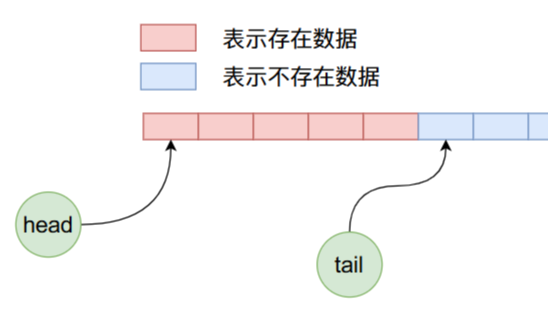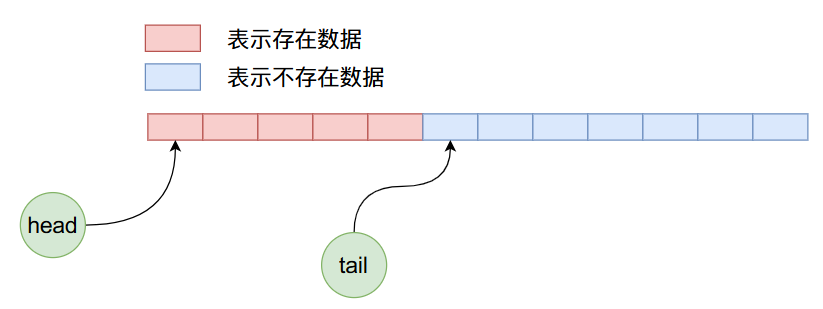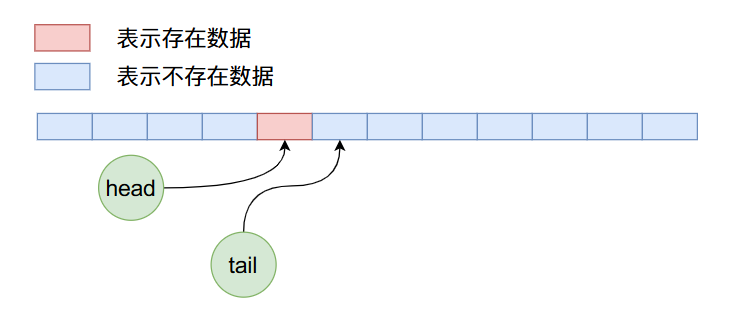阻塞佇列的主要的需求如下:
並發安全性的。
並發安全性的,而且我們也有將執行緒喚醒和阻塞的需求,因此我們可以選擇可重入鎖定ReentrantLock保證並發安全,但是我們還需要將執行緒喚醒和阻塞,因此我們可以選擇條件變數Condition進行執行緒的喚醒和阻塞操作,在Condition當中我們將會使用到的,主要有以下兩個函數:
signal用來喚醒線程,當一個執行緒呼叫Condition的signal函數的時候就可以喚醒一個被await函數阻塞的執行緒。
await用於阻塞線程,當一個線程呼叫Condition的await函數的時候這個線程就會阻塞。

 ##在上圖中的基礎之上我們在進行四次出隊操作,結果如下:
##在上圖中的基礎之上我們在進行四次出隊操作,結果如下:
 在上面的狀態下,我們繼續加入8個數據,那麼佈局情況如下:
在上面的狀態下,我們繼續加入8個數據,那麼佈局情況如下:
 我們知道上圖在加入資料的時候不僅將陣列後半部的空間使用完了,而且可以繼續使用前半部沒有使用過的空間,也就是說在佇列內部實作了一個循環使用的過程。
我們知道上圖在加入資料的時候不僅將陣列後半部的空間使用完了,而且可以繼續使用前半部沒有使用過的空間,也就是說在佇列內部實作了一個循環使用的過程。
為了確保數組的循環使用,我們需要用一個變數記錄隊列頭在數組當中的位置,用一個變量記錄隊列尾部在數組當中的位置,還需要有一個變量記錄隊列當中有多少個數據。
程式碼實作
// 用于保护临界区的锁 private final ReentrantLock lock; // 用于唤醒取数据的时候被阻塞的线程 private final Condition notEmpty; // 用于唤醒放数据的时候被阻塞的线程 private final Condition notFull; // 用于记录从数组当中取数据的位置 也就是队列头部的位置 private int takeIndex; // 用于记录从数组当中放数据的位置 也就是队列尾部的位置 private int putIndex; // 记录队列当中有多少个数据 private int count; // 用于存放具体数据的数组 private Object[] items;
建構子
@SuppressWarnings("unchecked")
public MyArrayBlockingQueue(int size) {
this.lock = new ReentrantLock();
this.notEmpty = lock.newCondition();
this.notFull = lock.newCondition();
// 其实可以不用初始化 类会有默认初始化 默认初始化为0
takeIndex = 0;
putIndex = 0;
count = 0;
// 数组的长度肯定不能够小于0
if (size <= 0)
throw new RuntimeException("size can not be less than 1");
items = (E[])new Object[size];
}put函數
public void put(E x){
// put 函数可能多个线程调用 但是我们需要保证在给变量赋值的时候只能够有一个线程
// 因为如果多个线程同时进行赋值的话 那么可能后一个线程的赋值操作覆盖了前一个线程的赋值操作
// 因此这里需要上锁
lock.lock();
try {
// 如果队列当中的数据个数等于数组的长度的话 说明数组已经满了
// 这个时候需要将线程挂起
while (count == items.length)
notFull.await(); // 将调用 await的线程挂起
// 当数组没有满 或者在挂起之后再次唤醒的话说明数组当中有空间了
// 这个时候需要将数组入队
// 调用入队函数将数据入队
enqueue(x);
} catch (InterruptedException e) {
e.printStackTrace();
} finally {
// 解锁
lock.unlock();
}
}
// 将数据入队
private void enqueue(E x) {
this.items[putIndex] = x;
if (++putIndex == items.length)
putIndex = 0;
count++;
notEmpty.signal(); // 唤醒一个被 take 函数阻塞的线程唤醒
}offer函數
,而不是被阻塞。 <div class="code" style="position:relative; padding:0px; margin:0px;"><pre class='brush:php;toolbar:false;'>public boolean offer(E e) {
final ReentrantLock lock = this.lock;
lock.lock();
try {
// 如果数组满了 则直接返回false 而不是被阻塞
if (count == items.length)
return false;
else {
// 如果数组没有满则直接入队 并且返回 true
enqueue(e);
return true;
}
} finally {
lock.unlock();
}
}</pre><div class="contentsignin">登入後複製</div></div>add函數
public boolean add(E e) {
if (offer(e))
return true;
else
throw new RuntimeException("Queue full");
}take函數
public E take() throws InterruptedException {
// 这个函数也是不能够并发的 否则可能不同的线程取出的是同一个位置的数据
// 进行加锁操作
lock.lock();
try {
// 当 count 等于0 说明队列为空
// 需要将线程挂起等待
while (count == 0)
notEmpty.await();
// 当被唤醒之后进行出队操作
return dequeue();
}finally {
lock.unlock();
}
}
private E dequeue() {
final Object[] items = this.items;
@SuppressWarnings("unchecked")
E x = (E) items[takeIndex];
items[takeIndex] = null; // 将对应的位置设置为 null GC就可以回收了
if (++takeIndex == items.length)
takeIndex = 0;
count--; // 队列当中数据少一个了
// 因为出队了一个数据 可以唤醒一个被 put 函数阻塞的线程 如果这个时候没有被阻塞的线程
// 这个函数就不会起作用 也就说在这个函数调用之后被 put 函数挂起的线程也不会被唤醒
notFull.signal(); // 唤醒一个被 put 函数阻塞的线程
return x;
}重寫toString函數
方法得到一個字串,最後列印這個字串。 <div class="code" style="position:relative; padding:0px; margin:0px;"><pre class='brush:php;toolbar:false;'>@Override
public String toString() {
StringBuilder stringBuilder = new StringBuilder();
stringBuilder.append("[");
// 这里需要上锁 因为我们在打印的时候需要打印所有的数据
// 打印所有的数据就需要对数组进行遍历操作 而在进行遍历
// 操作的时候是不能进行插入和删除操作的 因为打印的是某
// 个时刻的数据
lock.lock();
try {
if (count == 0)
stringBuilder.append("]");
else {
int cur = 0;
// 对数据进行遍历 一共遍历 count 次 因为数组当中一共有 count
// 个数据
while (cur != count) {
// 从 takeIndex 位置开始进行遍历 因为数据是从这个位置开始的
stringBuilder.append(items[(cur + takeIndex) % items.length].toString() + ", ");
cur += 1;
}
// 删除掉最后一次没用的 ", "
stringBuilder.delete(stringBuilder.length() - 2, stringBuilder.length());
stringBuilder.append(&#39;]&#39;);
}
}finally {
lock.unlock();
}
return stringBuilder.toString();
}</pre><div class="contentsignin">登入後複製</div></div>完整程式碼
import java.util.concurrent.locks.Condition;
import java.util.concurrent.locks.ReentrantLock;
public class MyArrayBlockingQueue<E> {
// 用于保护临界区的锁
private final ReentrantLock lock;
// 用于唤醒取数据的时候被阻塞的线程
private final Condition notEmpty;
// 用于唤醒放数据的时候被阻塞的线程
private final Condition notFull;
// 用于记录从数组当中取数据的位置 也就是队列头部的位置
private int takeIndex;
// 用于记录从数组当中放数据的位置 也就是队列尾部的位置
private int putIndex;
// 记录队列当中有多少个数据
private int count;
// 用于存放具体数据的数组
private Object[] items;
@SuppressWarnings("unchecked")
public MyArrayBlockingQueue(int size) {
this.lock = new ReentrantLock();
this.notEmpty = lock.newCondition();
this.notFull = lock.newCondition();
// 其实可以不用初始化 类会有默认初始化 默认初始化为0
takeIndex = 0;
putIndex = 0;
count = 0;
if (size <= 0)
throw new RuntimeException("size can not be less than 1");
items = (E[])new Object[size];
}
public void put(E x){
lock.lock();
try {
while (count == items.length)
notFull.await();
enqueue(x);
} catch (InterruptedException e) {
e.printStackTrace();
} finally {
lock.unlock();
}
}
private void enqueue(E x) {
this.items[putIndex] = x;
if (++putIndex == items.length)
putIndex = 0;
count++;
notEmpty.signal();
}
private E dequeue() {
final Object[] items = this.items;
@SuppressWarnings("unchecked")
E x = (E) items[takeIndex];
items[takeIndex] = null;
if (++takeIndex == items.length)
takeIndex = 0;
count--;
notFull.signal();
return x;
}
public boolean add(E e) {
if (offer(e))
return true;
else
throw new RuntimeException("Queue full");
}
public boolean offer(E e) {
final ReentrantLock lock = this.lock;
lock.lock();
try {
if (count == items.length)
return false;
else {
enqueue(e);
return true;
}
} finally {
lock.unlock();
}
}
public E poll() {
final ReentrantLock lock = this.lock;
lock.lock();
try {
return (count == 0) ? null : dequeue();
} finally {
lock.unlock();
}
}
public E take() throws InterruptedException {
lock.lock();
try {
while (count == 0)
notEmpty.await();
return dequeue();
}finally {
lock.unlock();
}
}
@Override
public String toString() {
StringBuilder stringBuilder = new StringBuilder();
stringBuilder.append("[");
lock.lock();
try {
if (count == 0)
stringBuilder.append("]");
else {
int cur = 0;
while (cur != count) {
stringBuilder.append(items[(cur + takeIndex) % items.length].toString()).append(", ");
cur += 1;
}
stringBuilder.delete(stringBuilder.length() - 2, stringBuilder.length());
stringBuilder.append(']');
}
}finally {
lock.unlock();
}
return stringBuilder.toString();
}
}現在對上面的程式碼進行測試:
我們現在使用阻塞隊列模擬一個生產者消費者模型,設定阻塞隊列的大小為5,生產者線程會往隊列當中加入數據,數據為0-9的10個數字,消費者線程一共會消費10次。
import java.util.concurrent.TimeUnit;
public class Test {
public static void main(String[] args) throws InterruptedException {
MyArrayBlockingQueue<Integer> queue = new MyArrayBlockingQueue<>(5);
Thread thread = new Thread(() -> {
for (int i = 0; i < 10; i++) {
System.out.println(Thread.currentThread().getName() + " 往队列当中加入数据:" + i);
queue.put(i);
}
}, "生产者");
Thread thread1 = new Thread(() -> {
for (int i = 0; i < 10; i++) {
try {
System.out.println(Thread.currentThread().getName() + " 从队列当中取出数据:" + queue.take());
System.out.println(Thread.currentThread().getName() + " 当前队列当中的数据:" + queue);
} catch (InterruptedException e) {
e.printStackTrace();
}
}
}, "消费者");
thread.start();
TimeUnit.SECONDS.sleep(3);
thread1.start();
}
}上面程式碼的輸出如下所示:
生產者將資料加入佇列3
生產者將資料加入佇列當中:4
生產者往佇列當中加入資料:5
消費者從佇列當中取出資料:0
生產者往佇列當中加入資料:6
消費者目前隊列當中的資料:[1, 2, 3, 4, 5]
消費者從隊列當中取出資料:1
消費者目前隊列當中的資料:[2, 3, 4 , 5]
消費者從隊列當中取出資料:2
消費者目前隊列當中的資料:[3, 4, 5, 6]
生產者將資料加入資料在隊列中:7
消費者從隊列當中取出資料:3
消費者目前隊列當中的資料:[4, 5, 6, 7]
消費者從隊列當中取出資料:4
消費者目前隊列當中的資料:[5, 6, 7]
消費者從佇列當中取出資料:5
消費者目前佇列當中的資料:[6, 7]
生產者往佇列當中加入資料:8
消費者從佇列當中取出資料:6
消費者目前佇列當中的資料:[7, 8]
消費者從佇列當中取出資料:7
消費者目前佇列當中的資料: [8]
消費者從佇列當中取出資料:8
消費者目前佇列當中的資料:[]
生產者往佇列當中加入資料:9
消費者從佇列當中取出資料:9
消費者目前佇列當中的資料:[]
從上面的輸出結果我們知道,生產者執行緒列印5之後被掛起了,因為如果沒有被掛起,生產者線程肯定可以一次性輸出完成,因為消費者線程阻塞了3秒。由於阻塞佇列已滿,他在列印數字5後就未完成輸出,導致生產者線程被掛起。一旦消費者開始消費,阻塞隊列中就會騰出空間,生產者執行緒就可以繼續生產。
以上是怎麼利用Java手寫阻塞佇列的詳細內容。更多資訊請關注PHP中文網其他相關文章!




